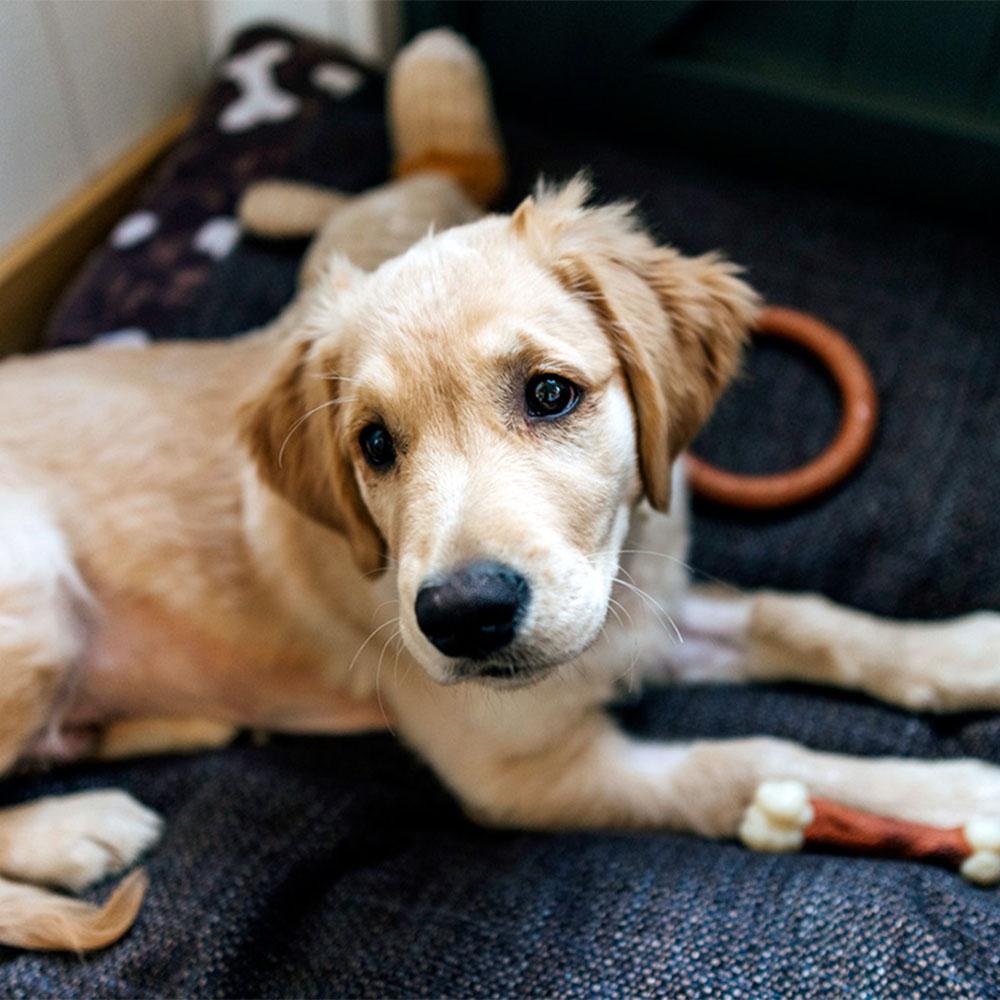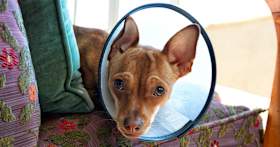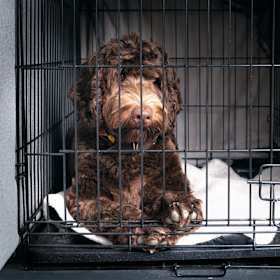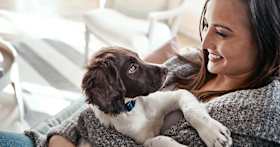What to Do When You Get a Puppy
Getting a puppy? Here's how to prepare like a pro.
Getting a puppy? Here's how to prepare like a pro.
by Katie Koschalk, | April 26, 2024

SolStock / iStock
Although bringing home a new puppy may not be as overwhelming as welcoming a new baby, there are some parallels. Both come with a lot of responsibility, a steep learning curve, and the need to clean up a fair amount of urine. To ensure a smooth start for you and your pup, it’s helpful to be equipped with the right supplies, knowledge, and mindset.
While these guidelines won’t cover all the details of raising a puppy (you can find more on that in our How to Raise a Puppy guide), they will assist you in preparing for the initial months with your new family member.
Where to begin? Let’s start by discussing how to prepare your home for your new pup.
Puppies are curious creatures, inclined to explore their surroundings. This makes it crucial to puppy-proof your living space before bringing your new pup home. This involves putting away or removing any potential hazards, such as toxic plants, electrical cords, small objects that could be swallowed, and household cleaners — just to name a few things.
Additionally, make sure your cabinets are securely closed, trash cans are out of reach, and any other areas that may entice your curious pup are made inaccessible.
Before the arrival of your new puppy, you’ll need to purchase all the necessary supplies, including:
A collar with an identification tag
A leash
Food and water bowls
High-quality puppy food and dog treats
A dog bed
A crate
Puppy-safe toys
Puppy-safe shampoo
Pet-safe home cleaner
Set up a puppy-proofed, enclosed area for times you cannot directly supervise your puppy. If your puppy is not yet house-trained, opt for an area with hardwood or tile floors for easier accident cleanups. Using a crate for short intervals of time is also a suitable option when you cannot closely monitor your puppy.
The first week with your new puppy is a whirlwind: adjusting to a new routine, tending to your puppy’s needs, and addressing any challenges that arise. This can feel like a lot. Here are some tips to make the transition smoother for everyone.
On your puppy’s first day in your home, they’ll likely shift between curiosity, nervousness, and excitement. To prevent them from feeling too overwhelmed, choose a designated area of your home where they can explore. Then, as they feel more comfortable, introduce them to the rest of your living space one room at a time.
Consistency is key in helping your puppy feel secure in their new home. Plan regular mealtimes, potty breaks, play sessions, and downtime to establish structure and routines.
It’s important to set rules from the get-go. If you don’t want your puppy to jump up on people or furniture as an adult, you must establish rules early on.
If the puppy does something undesirable, you can use a calm, firm “no.” But avoid a harsh tone and never yell or use physical punishment. Yelling and punishment only make your puppy scared of you and more anxious overall. The key is to reward positive behavior and redirect negative behaviors.
If you have cats or other dogs in your home, it’s important to introduce your new puppy to them slowly. Keep them in separate rooms at first and feed them on opposite sides of the door. This helps them associate the presence of the other pet with good things, such as food. With each feeding, move the bowls a little closer to the closed door. Continue this process until each pet is eating calmly right next to the door.
You can then allow them to sniff each other through a barrier, such as a cracked door or baby gate, to gauge their reactions. If you get positive signs from both pets, gradually introduce them in controlled, supervised settings, using positive reinforcement and rewards to encourage friendly interactions. Monitor their behaviors closely, and intervene if necessary to prevent any conflicts or aggression.
Training your puppy is vital for their development and safety. It also fosters a strong bond between you and your companion and shapes them into a well-behaved member of society. Here are some tips to get started:
Begin with basic obedience training: teaching your puppy commands like “sit,” “stay,” “come,” and “heel.” Use positive-reinforcement techniques, such as immediately rewarding good behavior with treats and praise. This creates an association between specific behaviors and positive outcomes, motivating your puppy to repeat those behaviors. Keep training sessions short, fun, and consistent to prevent boredom and frustration.
If you want clean floors, begin potty training right away. Plan for potty breaks about every two hours, as well as immediately upon waking up, after meals and water consumption, before bedtime, and any time your puppy is giving you signals like circling or sniffing around the room. Take your puppy to a designated bathroom area outdoors and use a verbal cue like “go potty” to encourage them to do their business.
Reward successful potty trips with treats and praise, and clean up accidents indoors calmly and without punishment. Scolding your puppy for accidents will not teach them a lesson — it will only make them scared of you and possibly lead to more accidents due to increased anxiety.
Crate training provides your puppy with a safe, comfortable space to rest, especially during times when you can’t keep a watchful eye on them. Start crate training by tossing a treat into the crate, saying a designated cue like, “Go to crate.” The second your dog places a foot in the crate, praise them and give them another treat. Do not close the crate door at this point.
As they become comfortable, continue with the same process but add in increasingly challenging steps: closing the door briefly, extending the duration of the closed door, walking away for a moment and then minutes at a time, and eventually leaving them in the crate unsupervised.
Puppies should only be crated for isolated amounts of time. A common recommendation is one hour of crate time for each month of age (with a cap of three to four hours at a time, except during nighttime sleep).
If your puppy is excessively barking, start by trying to identify the underlying cause, such as boredom, fear, or attention-seeking behavior. To prevent boredom, ensure your puppy is getting enough mental and physical stimulation. If they’re barking out of fear of something, remove the fearful stimulus (if possible), but if appropriate, try to slowly desensitize them to it.
If your puppy has all their needs met and they’re still barking, they’re likely doing it because they want more of something, like food or attention. In this case, you don’t want to give in to your puppy’s demands, as this teaches your dog that barking gets them what they want. Instead, calmly redirect their attention. Once they settle down, reward their quiet behavior with a treat.
Whining is often a sign of distress or discomfort in puppies. Address the underlying cause by ensuring your puppy’s needs are met, including food, water, bathroom breaks, and comfort.
If your puppy’s needs are met, they’re likely whining to get what they want, be it more food or attention. To avoid reinforcing whiny behavior, ignore it or calmly redirect your puppy’s attention. Once they stop whining, immediately reward them with praise and a treat to teach them that good things happen when they’re quiet.
In addition to training and care basics, here are some extra tips to help you and your new puppy navigate their early days together:
Socialization: Puppyhood is the best time to socialize a dog. Gradually introduce your puppy to various people, animals, experiences, and environments to help them become well-adjusted adults. Plan supervised playdates with friendly dogs, expose them to different sounds and sights, and enroll them in puppy socialization classes if possible.
Chewing: Puppies explore the world with their mouths and will likely chew on objects in your house. Provide plenty of puppy-safe chew toys to satisfy their natural urges to chew. Rotate these toys regularly to keep them engaged, offering different textures and shapes to prevent boredom.
Healthcare: Schedule a veterinary check-up for your puppy shortly after bringing them home, ideally within a few days. This is to confirm that they’re healthy and up-to-date on vaccinations and preventive care.
Grooming: Establish a grooming routine to keep your puppy clean and healthy, including regular baths, nail trims, and dental care.
Bonding: Spend quality time bonding with your puppy daily, whether through play, training, or simply cuddling on the couch. Building a strong bond with your puppy supports their emotional well-being and strengthens your relationship for years to come.
Patience and consistency: Raising a puppy takes time, patience, and consistency. Be patient with your puppy as they learn and grow, and remain consistent in your training methods and routines. Celebrate small victories and progress, and don’t be discouraged by setbacks or challenges along the way.
To train a puppy not to bite, redirect their attention to appropriate chew toys, or briefly withdraw interaction when they bite. This teaches them that biting leads to reduced attention and play, a consequence they’ll learn to avoid.
During your puppy’s first vet visit, expect a physical examination, any necessary vaccinations, and discussions about preventive care, nutrition, and behavior. Your vet may also address any concerns you have about your puppy’s health and offer guidance on future veterinary care and wellness routines.
Prepare kids for a new puppy by teaching them how to interact with the puppy gently and respectfully. Set clear boundaries and rules for not disturbing the puppy while they eat or sleep. Involving children in the puppy’s care routines can also help them learn about their new family members.
Crate Training by Dr. Karen Becker
How to Crate Train Your Dog or Puppy

Katie Koschalk is a freelance writer based in Northern California. Fusing her love and knowledge of animals with her journalism degree and years of professional writing, Katie is dedicated to improving the lives of pets and their caretakers by sharing helpful and accurate information. When she’s not at her desk, you can find her exploring trails with her Aussie, Hunter, cooking plant-based meals, and talking to her two cats, Jax and Sadie, in really ridiculous voices.

Adoption Advice

Adoption Advice

Behavior & Training

Adoption Advice
From flat collars to breakaway collars, here’s how to choose the best collar for your dog

Behavior & Training

Behavior & Training